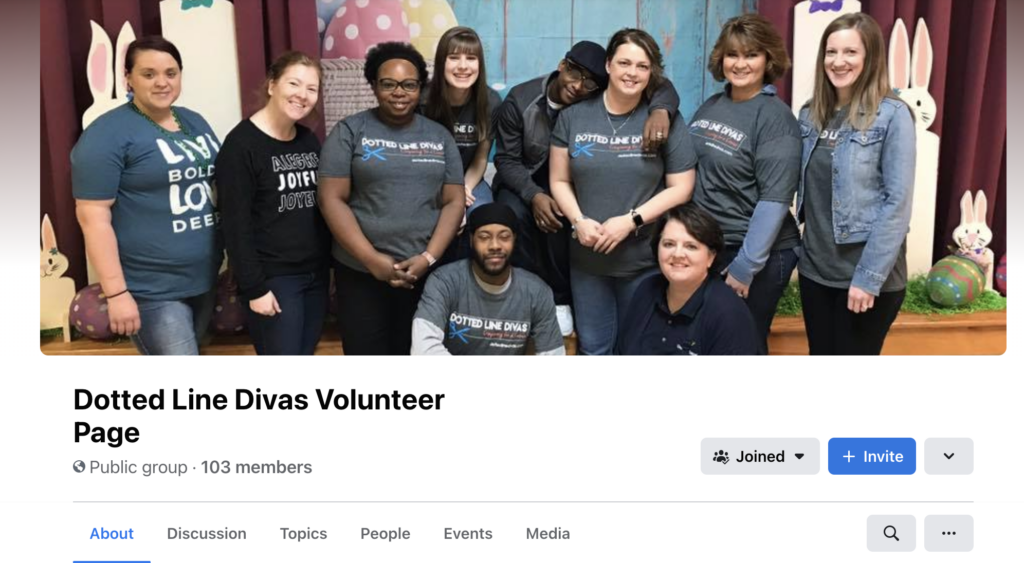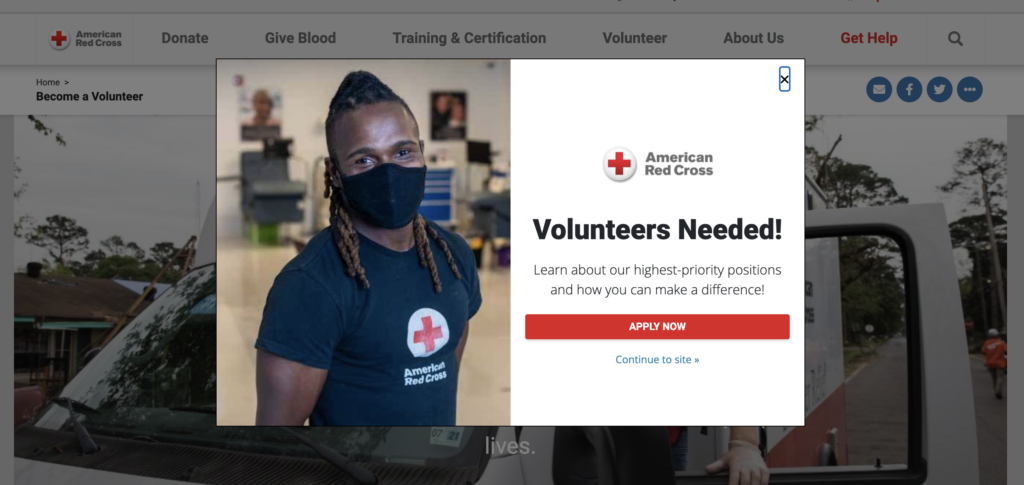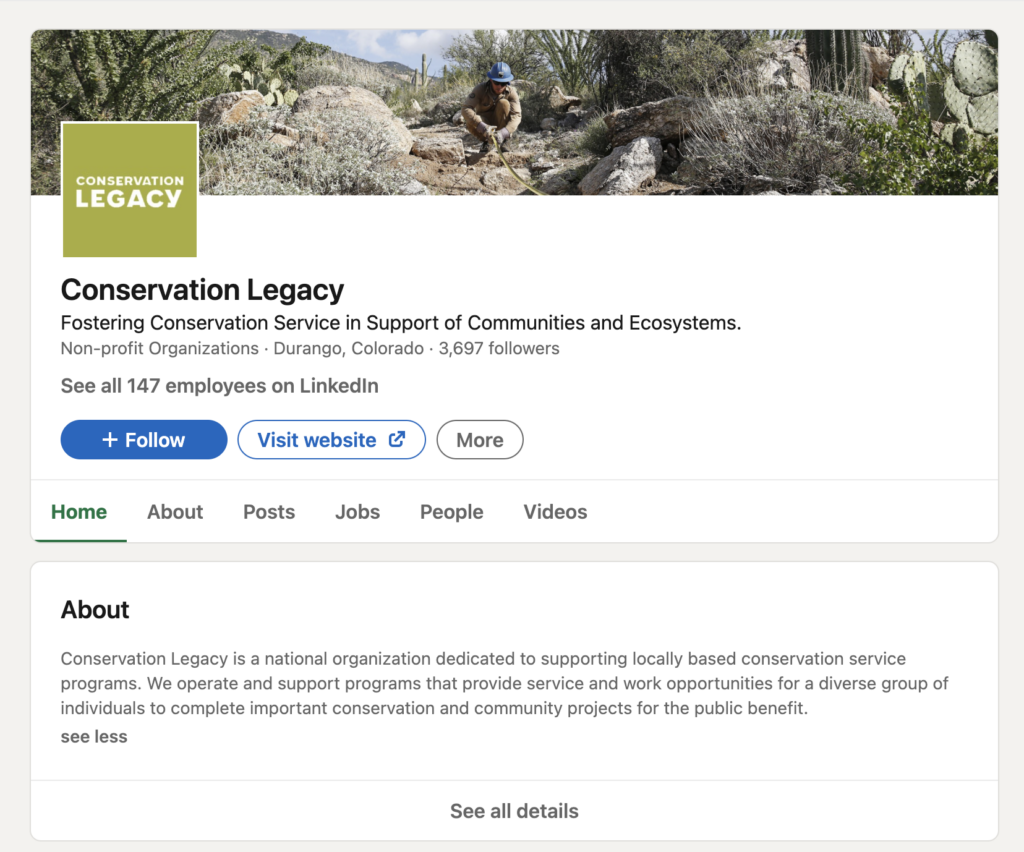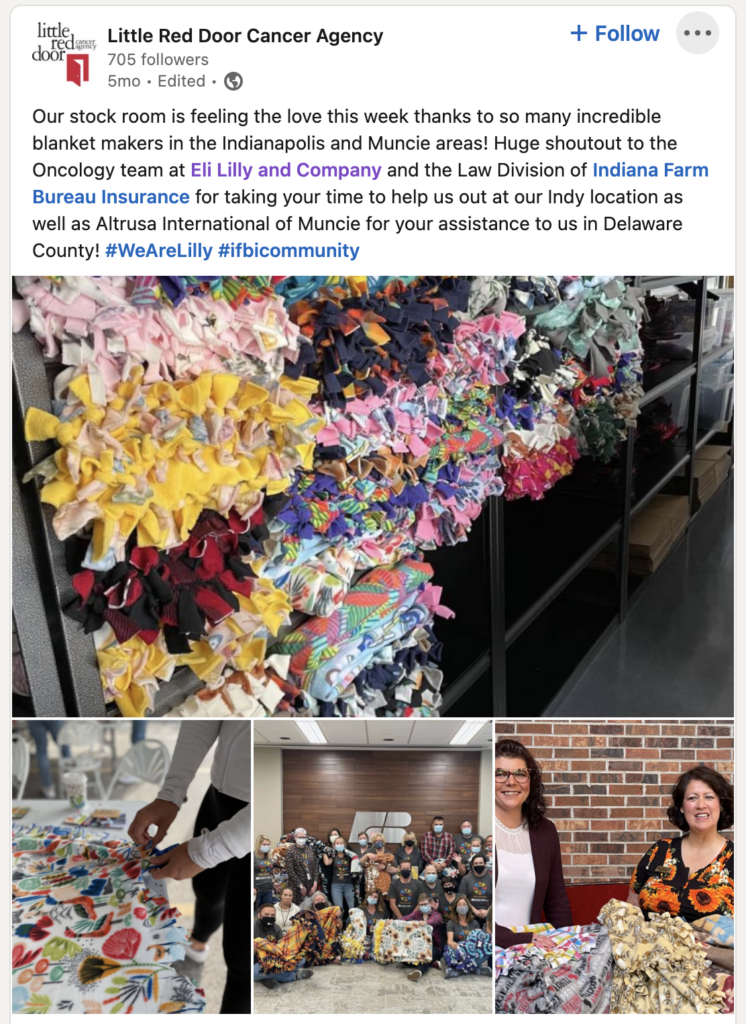At its core, nonprofit digital marketing is about using online tools to accomplish a goal. Your goal for a digital marketing campaign could be to encourage monetary donations, but nonprofits can also use digital marketing to find volunteers, raise awareness, gain attendees for an event, or to gain members for a club. This guide is by no means exhaustive, but we’ve included some ideas to help get your nonprofit started with digital marketing.
Remember that the best digital marketing campaigns often include multiple methods – for example, you could have a social media campaign on Facebook and Instagram, along with some email marketing and google ads. Digital marketing encompasses several channels and goals when it comes to nonprofits, so we’ve organized this article by starting with general tips. Then, we’ll dig into examples of nonprofits who use digital marketing well to accomplish different goals. As always, if you’d like assistance with your digital marketing campaigns, don’t hesitate to reach out – we’d be happy to see how we can help!
Top 4 Digital Marketing Musts for Nonprofits
1. Keep it consistent.
Your handle (the name your organization goes by on social media) should be consistent. If you’re just starting out making social media accounts for your nonprofit, make sure the handle you want is available on all the platforms you’d like to be on–whether it’s Facebook, Instagram, TikTok, Snapchat, etc. We’d recommend making it your nonprofit’s name if possible, or an easy-to-remember phrase or abbreviation.
For example, if your nonprofit is called “The National Coalition Dedicated to Treefrog Conservation”, a good handle might be @treefrogcoalition or @treefrogconservation, rather than the whole abbreviation of @ncdtc. You want to make this something that is easy to remember and identify you by because it’ll be what people use if they want to tag or mention your nonprofit. The most common reason people would mention your nonprofit online is to help you get more volunteers or donors, so it’s in your best effort to make it as easy as possible for them.
It’s wise to have consistency across channels. For example, if your email marketing comes from “Katie’s Animal Shelter,” then your website should be katiesanimalshelter.com and your handle should be @katiesanimalshelter. By keeping your name consistent across platforms, you avoid confusion or mix ups with organizations with similar names or missions.
2. Make it easy to find your organization online.
It seems simple, but make sure your nonprofit is easy to find on each platform you’re on online. With google, we always recommend having branded keywords in your free google grant account. This means you’ll make free google ads so that when anyone searches for your nonprofit’s name online, your website will be the one that pops up near the top of the page.
On platforms like Instagram, when someone searches for an organization like yours, there’s a way to help your organization show up further towards the top of the list. When you create or edit your profile in Instagram, the username is your handle, but the “name” is a searchable feature that shows up on your profile and directs people to your page. If you have name recognition, use your organization’s name. But if you are a small or mid-sized organization, use those 30 characters to succinctly say what you do. This tip especially applies for organizations who have names that don’t make it obvious what they do or for organizations that had to use a shorter version of their name for their handle.
For example, Nashville First Baptist Church has a fantastic snappy handle (and website URL!) of @nashvillefirst. It’s short and easy to remember for all their followers. But they’ve included their full name “Nashville First Baptist Church” as their name on Instagram, so that when someone searches terms like “nashville church” or “baptist church”, they’ll still show up. They keep a short handle while increasing their odds of showing up in the search.
3. Include a clear & easy call-to-action.
We go into more detail about calls-to-action in our free nonprofit website guide, but essentially, a call-to-action is a lot like what it sounds like. A call-to-action in marketing is how you tell people what action you want them to take and how to do it. For example, if you have a donate button on your website, that’s a call to action. People inherently know if they click the button, they’ll be taken to the page on your website where they can make a donation. The best calls-to-action are short and simple. Common calls-to-action could be “donate today!” or “volunteer now!” or for an awareness campaign, it could be something as simple as “learn more.” Your website, along with your digital marketing campaigns from emails to social media, should include some calls-to-action. You don’t need one for every social media post, though, otherwise the volume gets tiring.
4. Be on the right platforms and have a goal for each platform you’re using.
Your nonprofit should have set goals and objectives that guide the organization overall, but when it comes to marketing, it’s important to be on the right platforms to accomplish your goals. You likely won’t find tons of corporate sponsors using Twitter, but you might be able to engage them on Linkedin, for example. We believe nonprofits don’t need to be on every single platform available. With your limited amount of time and resources, pick the right channels for what your goals are. It’s better to do fewer platforms well than do every platform poorly.
Let’s say your nonprofit has two social media accounts: a Linkedin and a Facebook.
On Linkedin, you could work to engage your corporate sponsors and board members, and find new corporate volunteers. But on Facebook, your goal might be to engage your individual supporters and help people who need your nonprofit’s programs. When you create posts for those accounts, you’ll need to keep those goals in mind. If you’d like help with strategizing for social media and finding out which platforms are best to meet your goals, reach out to us for a free marketing consultation to get started.
Using Digital Marketing to Get More Volunteers
First, let’s dive into using digital marketing to gain volunteers. Before you start marketing your volunteering opportunities, make sure you have an easy way for volunteers to sign up online. If you’re managing a small amount of volunteers, this could be as simple as a free Google survey to sign up, a simple form on your website, or one of the dozens of online applications for sign ups or volunteer management. No matter what you choose, make sure that volunteers can send you their name, contact information, and their availability at the very least.
Now, to gain more volunteers, let’s take a look at some examples of how nonprofits use social media, email, website landing pages, and more to attract new volunteers and engage existing volunteers.
1. Find and Retain Volunteers on Facebook
If you’re looking to build your pool of volunteers, Facebook has a few options. Many nonprofits don’t know about the “community help” options on Facebook that are built for nonprofits specifically. In the community help section of Facebook, people can organize drives and find volunteers. For donation drives, we actually recommend Amazon’s options instead, but for finding volunteers, you can post opportunities to this section of Facebook. However, this feature of Facebook isn’t used widely in all areas. Instead, Facebook groups tend to be a more consistent way to find and engage volunteers. Many areas have groups dedicated to people with certain interests or who live in a certain neighborhood. Find and join groups that would appeal to your ideal volunteers. For example, if you run a cat shelter in Seattle, try looking for cat lovers or meetup groups, groups within the same neighborhood as your shelter, and groups for animal lovers in Seattle. When you post in the groups, be specific – tell people the date, time, and things they’ll be doing as volunteers. General “we need volunteers” posts tend to fall flat because people don’t know what’s being asked of them, so they don’t know if they can agree to it or not! Including a photo of people on previous volunteering days can also be a great way to show people what they’re signing up for.
If you have an existing pool of volunteers, but they don’t always return to volunteer more than once, having your own facebook volunteering group could help solve your problem. A non-food pantry in Indiana, Dotted Line Divas, uses a Facebook group to communicate with their volunteers. On this page, they keep volunteers up-to-date on the nonprofit’s successes and needs, and share photos of volunteers that ensure that others want to join in! Then, they share the link to sign up to volunteer when they need more volunteers to stock the pantry or help distribute items to families in need.
When making your volunteer group, make sure that you’re not just asking for volunteers – remember to share the awesome things your nonprofit is accomplishing to ensure they want to be part of it! We also recommend making your group public so other people in your area who are searching for volunteering opportunities can find and join your group. Your group description should also include your nonprofit’s mission statement, so that anyone who is unfamiliar with your nonprofit would easily understand what you do and how they can help as a volunteer.
2. Use Websites that Encourage Volunteer Sign Ups
First and foremost, make sure your website is volunteer-friendly. This means ensuring your mission is up front and clear, and your volunteering opportunities are specific and have an easy online sign up. Once your website is optimized, it’s time to spread your message.
VolunteerMatch is a website dedicated to helping nonprofits find volunteers. It’s structured much like a career-finder website, showing volunteers descriptions of volunteering positions in a list, based on their location. If your nonprofit is in a metro or suburban area, VolunteerMatch can be ideal for finding new volunteers.
Next, find your community’s online hubs. Your community could have an active discussion in Facebook groups, NextDoor, active networking groups, or a chamber of commerce. Join the conversations wherever they’re happening in your community, and odds are, you’ll be able to find people who care about your cause enough to lend a hand when your nonprofit needs it.
Many cities have what we call “connecting organizations.” Connecting organizations work to help nonprofits find supporters and volunteers through a variety of methods. This could be an organization with that specific purpose, or it could be a prominent organization in your area like a university (which could help you find student volunteers) or a networking group (to help you find corporate volunteers). Some organize in-person or virtual volunteer fairs for nonprofits to find new volunteers in the area, or some post about volunteering opportunities at different nonprofits on social media. Some even keep a running list of nonprofits looking for volunteers on their website.
In Indianapolis, IndyHub is a great example of this. They host an annual volunteer fair, and they have volunteering opportunities listed on their website at various nonprofits around the city. People can even search their list by the type of nonprofit they’d like to volunteer with. Finding your connecting organization can be a great way to gain exposure for your cause and gain new volunteers.
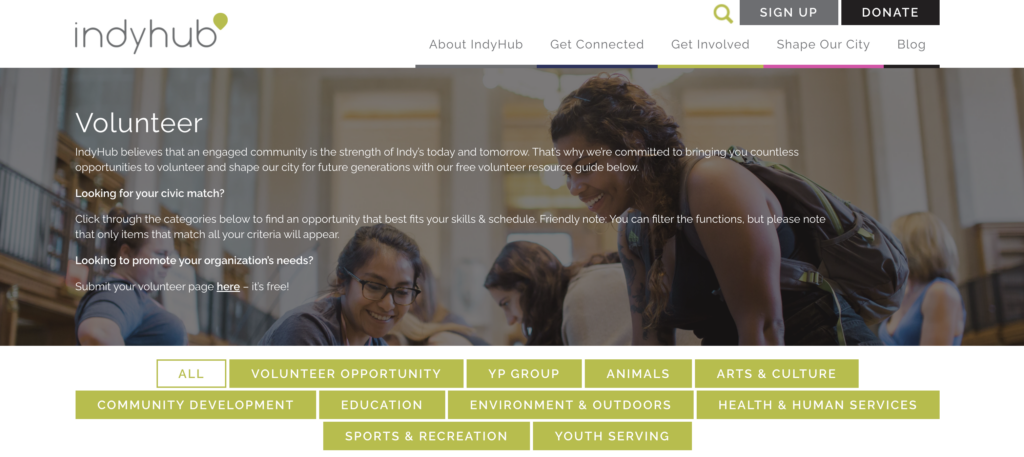
3. Re-Engage Existing and Former Volunteers with a Multi-Channel Campaign
If you’re wondering “what the heck is a multi-channel campaign?” don’t worry, you’re not alone! A multi-channel campaign is a marketing campaign that uses multiple channels (like email, Facebook, Instagram, Linkedin, GoogleAds, etc.) to achieve a unified goal. When it comes to engaging your volunteers, this is important because studies show that people often don’t act the first time they see something – it takes multiple “touches” for the message to sink in. This is why when you’re googling sandals, your ads on Facebook will likely show you sandals. For-profit companies are often great at showing you the same message on different platforms over and over again until you finally decide to add those sandals to your cart.
If you have a list of people who’ve expressed interest in getting involved with your nonprofit or have volunteered in the past, use it! You can send emails (we recommend more than one!), post on your social media accounts, and even add a pop up to your website, like this one on the American Red Cross’s website. You can even run a remarketing volunteer campaign in your google grant account, which will show your google ad to people who have visited your website before. It might feel like you’re putting your message in too many places, but most people won’t see every single one you send. Most of the time, people will only see a portion of the marketing materials you put out, so consistency and using multiple platforms will increase their chances of seeing your message more – increasing their likelihood to hit that “volunteer now” button!
Digital Marketing for Fundraising 101
One of the biggest questions we get is how nonprofits can use digital marketing to bring in more donations. Encouraging donations is absolutely possible with digital marketing, but it’s good to keep in mind that it should never be your entire fundraising strategy. Having good donor communication, throwing events, applying for grants, obtaining corporate sponsors, sending physical letters and so much more goes into a successful fundraising strategy. But let’s look at a few ways that digital marketing can be used to complement your overall fundraising strategy.
1. Run a Classic “Help us Reach our Goal” Marketing Campaign
Any nonprofit can run the age-old “help us reach our goal” campaign. First, start with a fundraising goal that has special meaning for your nonprofit, and includes something tangible. Having a year-end fundraising goal isn’t enough anymore – donors want to know what you’re going to do with their donation. Instead of saying “help us raise $1000 to help educate kids,” try saying, “help us raise $1,000 so we can help 100 at-risk youth graduate high school this year!”
Rose Haven, a nonprofit shelter and community center for women and children, did a great job of this with their campaign to reach $3 million. They tell people exactly why the goal is meaningful: It will help build a new shelter and home for the homeless in Portland, and they’re updating people on their progress to the goal. Providing updates can help people rally around your cause and can provide the extra push people need to be one to donate that last $25 to your campaign goal. With a “help us reach our goal” campaign, a multi-channel strategy is best – we suggest an email campaign, a landing page on your website, and a social media campaign. Keep in mind, no one likes to see an empty thermometer – so call a few of your supporters, whether it’s board members, corporate partners, or individuals, ahead of time and ask them for gifts towards the campaign. This way, you can be sure to have a progress update that includes being closer to your goal, which can be very encouraging for potential donors. Having a time limit is also a classic tactic to encourage quick giving.
2. Boost Your Corporate Giving Program
If your nonprofit doesn’t have corporate sponsors or you’re looking to amp up your existing program, digital marketing can certainly help. First, make sure your nonprofit has a polished and professional LinkedIn page like Conservation Legacy. They include their logo, a photo that clues people in to their mission, and a description that clearly and professionally states their mission.
While it’s not recommended to make tons of direct fundraising asks on LinkedIn, what you can do is engage current and potential corporate sponsors. Connect with them on Linkedin and be sure to thank them and tag them posts, whether they’ve just sponsored an event or they’ve come to your office to volunteer. If a company brings in toys for a toy drive, take a photo and post it on Linkedin, and be sure to tag them. Little Red Door Cancer Agency has a great example of engaging companies on LinkedIn. They thanked two corporate groups on Linkedin, tagged them, and posted photos of the volunteers from those groups. Posting about your corporate sponsors and volunteers is always a great way to thank them and encourage them to continue to help in the future.
The PR is great for the company, and it shows them that you’re appreciative for their involvement. And don’t forget– they’re likely proud of your organization and your cause, so they will often share or post about your organization as well. Be sure to engage with those posts. Happy and engaged corporate sponsors are more likely to continue to get involved, so don’t treat them like a one-and-done. Use LinkedIn as part of your overall relationship management strategy with them.
3. Don’t Neglect Your Email Strategy
One of the biggest mistakes nonprofits make is neglecting their email strategy when it comes to fundraising. Social Media can be a great tool, but people often pour all their time into social media without realizing they could be making more in donations through email marketing.
If you haven’t built an email list for your nonprofit yet, start there. Compile all the email addresses for donors, corporate partners, volunteers, event attendees, and anyone else who is involved with your nonprofit. You can get started with a simple email tool like Mailchimp (which offers a discount for nonprofits!).
Next, be sure you have opportunities in place to continue to grow your email list. Include a sign up form on your website, and be sure that whenever someone gets involved with your nonprofit in any capacity, you’ve got an email address for them on file. People can always unsubscribe if they’d like to, but most people who are involved do so because they care about their cause! They want to hear from you!
It seems counterintuitive, but in order to strengthen your fundraising via email, be sure that not all of your emails are about fundraising. If all you do is ask for money, but you never thank donors or update them on the great things your nonprofit is accomplishing, they’re going to want to unsubscribe. As a starting point, make sure that at least 50% of your emails are about your organization, programs, volunteers, and mission and then the other 50% can include an ask, whether you’re asking for the person to donate money, items, or time.
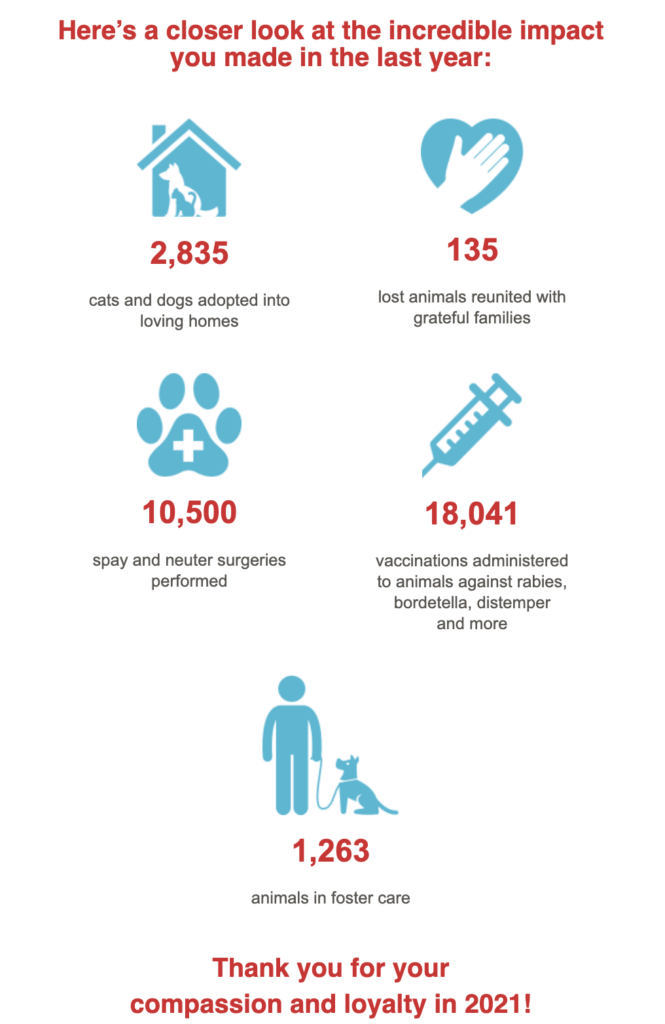
Pro tip: Be sure you send out your impact report via email each year, highlighting the incredible things your organization has accomplished in the last year with the help of your donors. When it comes to impact reports, be sure to use language that makes the donor feel included. For example, instead of saying “Our nonprofit helped 100 treefrogs this year,” you could say “Thanks to your support, 100 tree frogs have been saved from poaching.” When you make the donor feel included in your nonprofit’s successes, they can feel confident that their past and future donations are truly making a difference. Indy Humane did a great job of this in their impact report email this year.
Conclusion
We’ll continue to update this page with more tips and examples of nonprofits who are using digital marketing to further their missions– whether they’re gaining new volunteers, educating about their cause, or raising more funding. And if you need help in navigating the world of digital marketing for your nonprofit, request a consultation with one of our expert nonprofit marketers today.


